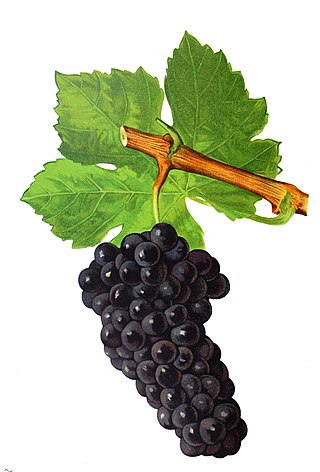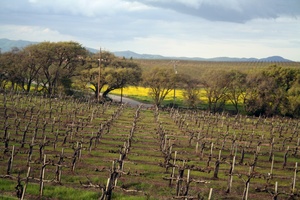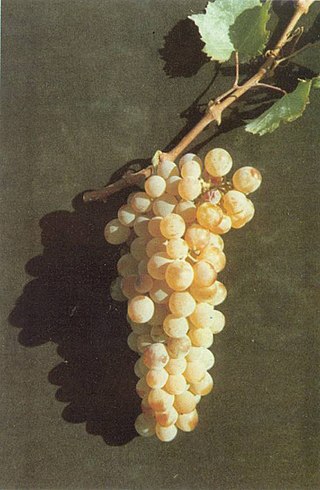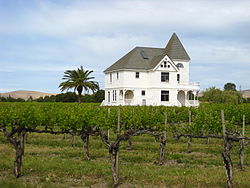
Pinot noir is a red-wine grape variety of the species Vitis vinifera. The name may also refer to wines created predominantly from pinot noir grapes. The name is derived from the French words for pine and black. The word pine alludes to the grape variety having tightly clustered, pinecone–shaped bunches of fruit.

Zinfandel is a variety of black-skinned wine grape. The variety is grown in over 10 percent of California vineyards. DNA analysis has revealed that it is genetically equivalent to the Croatian grapes Crljenak Kaštelanski and Tribidrag, as well as to the Primitivo variety traditionally grown in Apulia, Italy, where it was introduced in the 18th century, and Kratošija in Montenegro. The grape found its way to the United States in the mid-19th century, where it became known by variations of a name applied to a different grape, likely "Zierfandler" from Austria.

Roussanne is a white wine grape grown originally in the Rhône wine region in France, where it is often blended with Marsanne. It is the only other white variety, besides Marsanne, allowed in the northern Rhône appellations of Crozes-Hermitage AOC, Hermitage AOC and Saint-Joseph AOC. In the southern Rhône appellation of Châteauneuf-du-Pape AOC it is one of six white grapes allowed, where it may be blended into red wines. Roussanne is also planted in various wine-growing regions of the New World, such as California, Washington, Texas, South Africa and Australia as well as European regions such as Crete, Tuscany and Spain.

The Carménère grape is a wine grape variety originally planted in the Médoc region of Bordeaux, France, where it was used to produce deep red wines and occasionally used for blending purposes in the same manner as Petit Verdot.

Durif is a variety of red wine grape primarily grown in Australia, California, France, and Israel. Since the end of the 20th century, wineries located in Washington's Yakima River Valley, Maryland, Arizona, Texas, West Virginia, Chile, Mexico's Baja California Peninsula, and Ontario's Niagara Peninsula have also produced wines from Durif grapes. It is the main grape known in the U.S. and Israel as Petite Sirah, with over 90% of the California plantings labeled "Petite Sirah" being Durif grapes; the U.S. Bureau of Alcohol, Tobacco, Firearms and Explosives (ATF) recognizes "Durif" and "Petite Sirah" as synonyms for the same grape. It produces tannic wines with a spicy, plummy flavour. The grape originated as a cross of Syrah pollen germinating a Peloursin plant. On some occasions, Peloursin and Syrah vines may be called Petite Sirah, usually because the varieties are extremely difficult to distinguish in old age.

Ruby Cabernet is a red Olmo grape variety that is a cross between Cabernet Sauvignon and Carignan. It can produce wines with good colour and a pleasant cherry flavour, but is mostly blended into bulk wines.

The Livermore Valley AVA is an American Viticultural Area in Alameda County, California, surrounding the city of Livermore in the Tri-Valley region. Both the AVA and the city are named after Robert Livermore, a landowner whose holdings encompassed the valley. The groundwater basin underlying the valley is the Livermore Basin, the largest sub-unit of which is the Mocho Subbasin. The Livermore Basin is one of five aquifers in the San Francisco Bay Area that supply most of the metropolitan Bay Area population. The entire Livermore Basin aquifer faces a concern over elevated total dissolved solids by the year 2020 due to an expanding human population leading to higher rates of return water flows to the aquifer containing certain salts.

Assyrtiko or Asyrtiko is a white Greek wine grape indigenous to the island of Santorini. Assyrtiko is widely planted in the arid volcanic-ash-rich soil of Santorini and other Aegean islands, such as Paros. It is also found on other scattered regions of Greece such as Chalkidiki. Assyrtiko is also being grown by the Paicines Ranch Vineyard in the San Benito AVA of California with Margins Wine making the wine, by Jim Barry Wines in Clare Valley, South Australia, at the Abbey of New Clairvaux in Northern California since 2011, and at Kefi Winery in Monroe, North Carolina by a first generation Greek family. The original Assyrtiko cuttings were imported in the USA in 1948 by Harold Olmo, grape breeder at the University of California, Davis, where they were stored until the abbey of New Clairvaux took interest in the early 2000s.

Tannat is a red wine grape, historically grown in South West France in the Madiran AOC, and is now one of the most prominent grapes in Uruguay, where it is considered the "national grape".

Harold Olmo was an American viticulturist and professor at the University of California, Davis where he created many new grape varieties known today as Olmo grapes. In the 1950s, he helped to establish California's first quarantine facility on the UC Davis campus to permit California growers to import foreign vines. This led to an expansion of California's wine industry as more Vitis vinifera was introduced to the area.

Paul Draper is a California winemaker who has been the chief winemaker at Ridge Vineyards in California since 1969. Without any formal training in winemaking, Draper first gained recognition for his 1971 Monte Bello Cabernet Sauvignon when it placed fifth at the Judgment of Paris wine tasting. Draper has played a significant role in the history of California wine through his pioneering work in popularizing "vineyard-designated" wines as well as instigating the resurgence of old vine Zinfandel. Along with Ravenswood Winery's Joel Peterson, Draper is considered one of the most important figures in the history of Californian Zinfandel, rescuing the grape from obscurity and demonstrating its full potential as a serious wine. Draper was featured in a short film titled Terroir and directed by Christopher McGilvray which was shown at the 2017 Cinequest Film Festival.

Mondeuse noire is a red French wine grape variety that is grown primarily in the Savoy region of eastern France. The grape can also be found in Argentina, Australia, California, Switzerland and Sicily. Plantings of Mondeuse noire was hit hard during the phylloxera epidemic of the mid to late 19th century which nearly wiped out the vine from eastern France. While the grape recovered slightly in the 20th century, French plantations of Mondeuse noire fell sharply in the 1970s, with just over 200 hectares left in France in 2000. In the early 21st century, it seems the variety has increased somewhat in popularity, as it can give good wines if the planting site is chosen carefully.

B.R. Cohn Winery is a winery in Sonoma Valley, California in the United States.
The Guenoc Valley AVA is an American Viticultural Area in Lake County, California, United States, about 15 mi (24 km) north of the town of Calistoga. Guenoc Valley AVA was the first American Viticultural Area designation granted to an area with just a single winery.

California wine production has a rich viticulture history since 1680 when Spanish Jesuit missionaries planted Vitis vinifera vines native to the Mediterranean region in their established missions to produce wine for religious services. In the 1770s, Spanish missionaries continued the practice under the direction of the Father Junípero Serra who planted California's first vineyard at Mission San Juan Capistrano.

Mexican wine and wine making began with the arrival of the Spanish in the 16th century, when they brought vines from Europe to modern day Mexico, the oldest wine-growing region in the Americas. Although there were indigenous grapes before the Spanish conquest, the Spaniards found that Spanish grapevines also did very well in the colony of New Spain (Mexico) and by the 17th century wine exports from Spain to the New World fell. In 1699, Charles II of Spain prohibited wine making in Mexico, with the exception of wine for Church purposes. From then until Mexico’s Independence, wine was produced in Mexico only on a small scale.

Bianchi Winery is a winery in Paso Robles, California. The property includes the winery, a tasting room and a vineyard house for guest accommodations, all located among the estate vineyards. Bianchi Winery produces approximately 10,000 cases annually.
Hanzell Vineyards is a California wine producer located just outside the town of Sonoma. The winery was founded by James David Zellerbach who acquired 200 acres in the Mayacamas Mountains in 1943 and began planting Pinot Noir and Chardonnay in 1953. At the time, the entire state of California had fewer than 200 acres planted to Chardonnay.

Red Willow Vineyard is a grape-growing estate located in the far western end of Yakima Valley AVA, within the Yakama Indian Reservation. Beginning with their relationship with Columbia Winery and Master of Wine David Lake, grapes from Red Willow have been used to produce some of the most critically acclaimed Washington wines with the vineyard's name regularly being featured on vineyard designated wines. Paul Gregutt, wine writer for the Seattle Times and Wine Enthusiast, list Red Willow as one of the "top ten" vineyards in the entire state.
The Zinfandel Advocates and Producers(ZAP) is a consortium of over 200 winemakers and grape growers, as well as thousands of consumers, with the purpose of advocating, preserving, and educating about the Zinfandel grape. Started in 1991, the organizational structure of combining wine enthusiasts with wine producers served as a successful template for other wine-related organizations, such as the Rhone Rangers. ZAP is reported to be one of the largest consumer-based wine advocacy groups in the world.


















